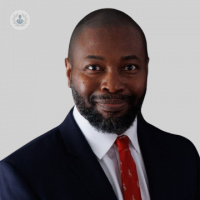What to know about facial injuries after accidents
Written in association with:In this article below, Professor Kavin Andi, a highly esteemed consultant oral and maxillofacial surgeon, discusses facial injuries after an accident and how they are typically treated.

What are the immediate steps to take after a facial injury in an accident?
Immediate steps to take after a facial injury in an accident are crucial for preventing further harm and ensuring proper healing. First, assess the injury to determine its severity, checking for signs of bleeding, swelling, and potential fractures.
If there is bleeding, apply gentle pressure with a clean cloth or sterile gauze to stop it. Clean the wound with clean water to remove any dirt or debris, but avoid using harsh substances like hydrogen peroxide or alcohol. Apply a cold compress to reduce swelling and numb the pain, using it for 10 to 15 minutes at a time. If fractures are suspected, don’t move the area to prevent further injury. Seeking maxillofacial advice prompts.
What types of facial injuries commonly occur in accidents?
Facial injuries are a common consequence of accidents, ranging from minor to severe. Cuts and lacerations frequently occur, often requiring stitches due to the face’s delicate skin and abundant blood vessels. Bruises and contusions are also common, leading to swelling and discolouration. Fractures are significant concerns, particularly affecting the nose, cheekbones, jaw, and orbital bones, which can cause both functional and cosmetic issues.
How do facial fractures impact the appearance and function of the face?
Facial fractures can significantly impact both the appearance and function of the face. These fractures often result in visible deformities, such as asymmetry, swelling, and bruising, which can alter the natural contours and overall aesthetics of the face.
Functionally, facial fractures can impair essential activities such as eating, speaking, and breathing. For instance, a broken jaw can make it difficult to chew and speak, while fractures around the eyes can affect vision and eye movement.
Additionally, nasal fractures can obstruct airflow, leading to breathing difficulties. The complex structure of facial bones and their proximity to critical sensory organs mean that fractures can have a profound effect on both the look and operational capabilities of the face, often requiring surgical intervention to restore normal appearance and function.
What are the treatment options for facial fractures?
Treatment options for facial fractures vary depending on the type and severity of the fracture. Initial treatment often includes managing pain and swelling with ice packs and medications. Minor fractures might only require rest and protective measures, such as avoiding strenuous activities that could worsen the injury. More severe fractures may necessitate surgical intervention to realign and stabilise the bones.
This can involve the use of plates, screws, or wires to ensure proper healing. In some cases, particularly with complex fractures affecting the jaw or orbital bones, reconstructive surgery may be required to restore both function and appearance. Advanced treatments, including the use of 3D imaging and custom implants, are increasingly available to enhance surgical outcomes and recovery for patients with facial fractures.
How does the severity of the injury affect the treatment plan?
The severity of a facial injury significantly influences the treatment plan, dictating the urgency, complexity, and type of medical interventions required. For minor injuries, such as superficial cuts or bruises, treatment may involve basic first aid measures, including cleaning the wound, applying antiseptic, and bandaging. Pain management with over-the-counter medications might suffice.
Moderate injuries, like deeper lacerations or simple fractures, generally require more intensive care, potentially involving sutures, prescription pain relief, and possibly minor surgical procedures to ensure proper healing and alignment. Severe facial injuries, such as multiple fractures, extensive soft tissue damage, or injuries impacting vital functions (e.g., breathing, vision), require comprehensively planned surgical care.
Can facial lacerations and cuts be repaired without leaving noticeable scars?
Facial lacerations and cuts can often be repaired with minimal or unnoticeable scarring, particularly when treated promptly and properly. The likelihood of achieving this outcome is significantly enhanced by immediate professional care, which ensures that wounds are thoroughly cleaned and precisely closed to prevent infection and promote optimal healing. The natural lines of the face, known as Langer’s lines, are often considered during closure to make any resultant scars less conspicuous.
Post-treatment care is also crucial; keeping the wound clean and moist, avoiding sun exposure, and using silicone sheets or gels can aid in reducing scar formation. Additionally, advanced treatments like laser therapy and microneedling can further diminish the appearance of scars if they develop.
Individual factors such as age, skin type, and genetic predisposition to scarring also play a role in the healing process. While it is challenging to guarantee that no scars will form, these strategies significantly increase the chances of achieving minimal and less noticeable scarring.
Are there non-surgical options for fixing facial injuries?
Yes, there are several non-surgical options for fixing facial injuries, depending on the nature and severity of the injury. For minor lacerations and cuts, surgeons often use methods such as tissue adhesives (skin glue), steri-strips, or medical tapes to close the wound, promoting healing without the need for stitches.
Bruises and swelling can be managed with cold compresses, anti-inflammatory medications, and topical treatments to reduce inflammation and pain. Non-surgical cosmetic procedures, such as dermal fillers and Botox, can address minor disfigurements or asymmetries caused by facial trauma, improving appearance and function without invasive surgery.
Advanced laser treatments and microneedling can help reduce the appearance of scars and improve skin texture, promoting the healing of damaged tissue. Physical therapy and facial exercises may be recommended to restore function and mobility in cases of nerve damage or muscle injury. These non-surgical approaches provide effective solutions for many facial injuries, minimising downtime and the risks associated with surgery.
If you’d like to consult with Professor Kavin Andi today, head over to his Top Doctors profile.


